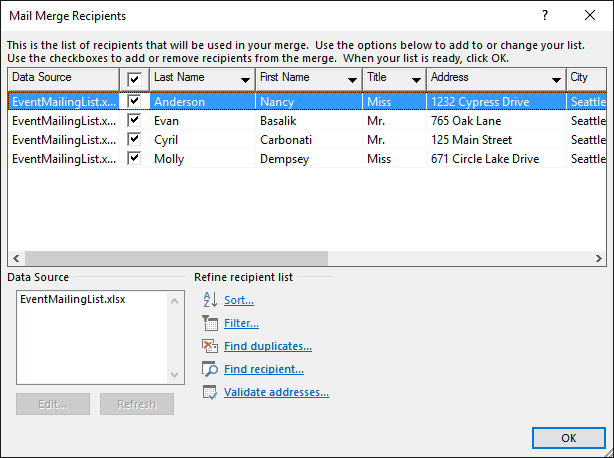Not known Incorrect Statements About Excel Links Not Working
Table of ContentsSome Known Questions About Excel Links Not Working.Some Of Excel Links Not WorkingExcitement About Excel Links Not WorkingExcel Links Not Working - An OverviewLittle Known Questions About Excel Links Not Working.

Selection computation features like either can not take care of entire column recommendations or calculate all the cells in the column. User-defined functions don't instantly recognize the last-used row in the column as well as, therefore, frequently determine entire column references inefficiently. Nevertheless, it is very easy to program user-defined functions so that they acknowledge the last-used row (excel links not working).

Excel Links Not Working Can Be Fun For Everyone
Utilizing the formula for a vibrant variety is generally more effective to the formula due to the fact that has the disadvantage of being a volatile function that will certainly be calculated at every recalculation. Performance reduces since the function inside the vibrant range formula should examine numerous rows.$A$ 1) - 1,1) You can additionally utilize features such as to build dynamic arrays, however is volatile and also always computes single-threaded.
Utilizing multiple vibrant varieties within a solitary column needs special-purpose counting features. Utilizing numerous vibrant ranges can lower performance. In Office 365 variation 1809 and also later, Excel's VLOOKUP, HLOOKUP, and MATCH for specific suit on unsorted information is much faster than ever before when searching for several columns (or rows with HLOOKUP) from the very same table array.
If you make use of the precise suit choice, the calculation time for the function is symmetrical to the number of cells scanned before a match is found. Lookup time making use of the approximate match alternatives of,, as well as on sorted information is rapid and is not considerably increased by the size of the variety you are looking up.
Excel Links Not Working - Questions
Ensure that you recognize the match-type and also range-lookup options in,, as well as. see post The adhering to code example reveals the syntax for the feature. SUIT(lookup value, lookup range, matchtype) returns the biggest suit much less than or equal to the lookup worth when the lookup selection is arranged ascending (approximate match).
The default choice is approximate suit sorted rising. The adhering to code instance reveals the syntax for the and features.
VLOOKUP(lookup value, table range, col index num, range-lookup) HLOOKUP(lookup value, table array, row index num, range-lookup) returns the largest suit less than or equal to the lookup worth (approximate suit). Table array should be arranged rising.
Not known Facts About Excel Links Not Working
If your data is sorted, however you desire an exact suit, see Use two lookups for sorted data with missing out on values. Try utilizing the and also works rather of. Although is slightly quicker find here (roughly 5 percent much faster), easier, and also makes use of much less memory than a mix of and, or, the added adaptability that and deal often enables you to considerably save time.
The feature is fast and also is a non-volatile function, which speeds up recalculation. The function is also quickly; nonetheless, it is a volatile function, as well as it sometimes significantly increases the time taken to process the calculation chain.$A$ 2:$F$ 1000, SUIT(A1,$A$ 1:$A$ 1000,0),3) Due to the fact that precise suit lookups can be slow-moving, consider the adhering to choices for boosting performance: Use one worksheet.
When you can, the information first (is fast), and use approximate match. When you have to use a precise suit lookup, limit the series of cells to be checked to a minimum. Use tables and structured references or dynamic variety names as opposed to referring to a multitude of rows or columns.
Fascination About Excel Links Not Working
2 approximate matches are dramatically faster than one specific match for a lookup over even more than a couple of rows. (The breakeven factor is regarding 10-20 rows.) If you can arrange your information however still can not use approximate suit due to the fact that you can not make sure that the worth you are looking up exists in the lookup array, you can use this formula: IF(VLOOKUP(lookup_val, lookup_array,1, True)=lookup_val, _ VLOOKUP(lookup_val, lookup_array, column, Real), "notexist") The first part of the formula functions by doing an approximate lookup on the lookup column itself.
VLOOKUP(lookup_val, lookup_array, column, True) If the answer his explanation from the lookup column did not match the lookup value, you have a missing worth, and also the formula returns "notexist". Understand that if you seek out a worth smaller sized than the smallest value in the checklist, you receive a mistake. You can handle this error by making use of, or by including a little examination value to the list.
Starting with Excel 2007, you can use the function, which is both easy as well as rapid. IF IFERROR(VLOOKUP(lookupval, table, 2 FALSE),0) In earlier versions, a straightforward yet slow-moving way is to make use of a function that consists of two lookups. IF(ISNA(VLOOKUP(lookupval, table,2, FALSE)),0, _ VLOOKUP(lookupval, table,2, FALSE)) You can avoid the dual specific lookup if you use specific once, save the outcome in a cell, and after that check the result prior to doing an.